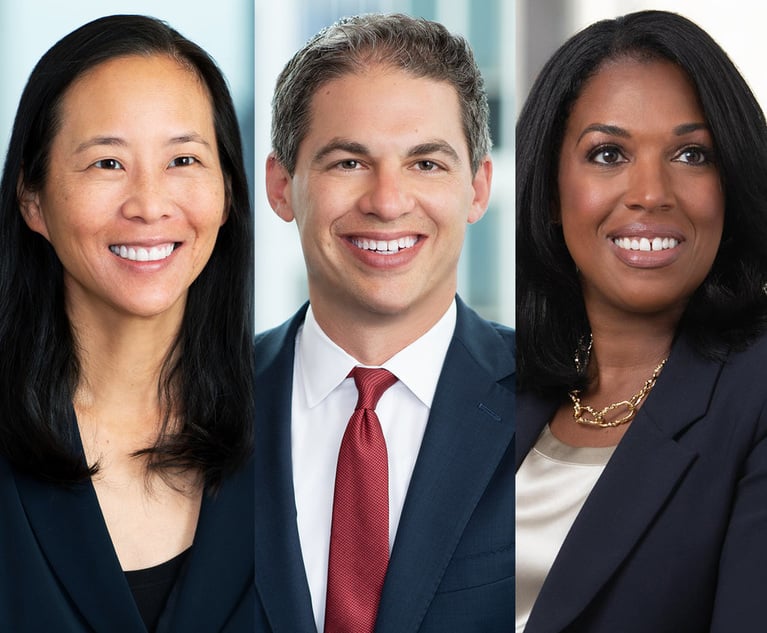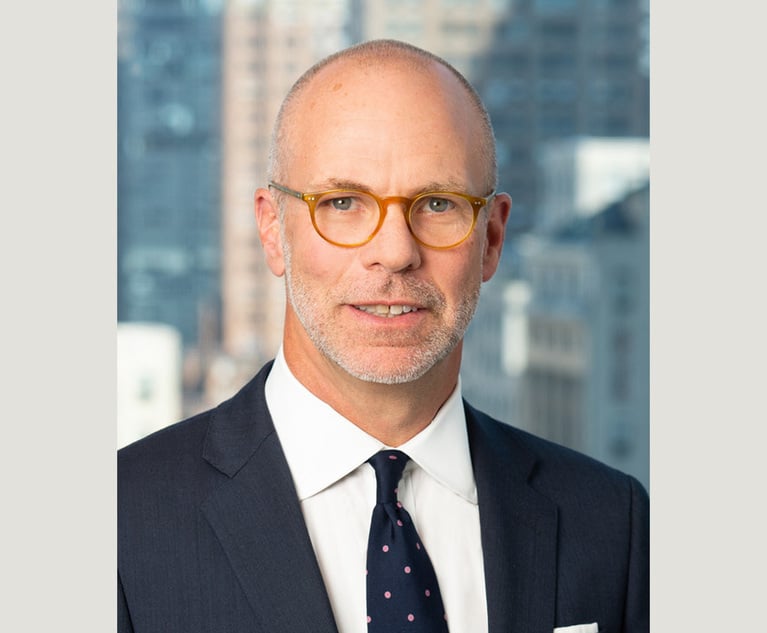Plaintiffs Lawyer Advertising Proves Ever Bolder
Anyone who's driven on the highway or watched daytime television has likely seen one: an ad, complete with a toll-free number and maybe a catchphrase or a jingle, plugging a lawyer who can help someone who's been hurt in a slip-and-fall incident or by something more serious, like asbestos exposure.
June 14, 2017 at 07:56 PM
5 minute read
The original version of this story was published on The Legal Intelligencer
Anyone who's driven on the highway or watched daytime television has likely seen one: an ad, complete with a toll-free number and maybe a catchphrase or a jingle, plugging a lawyer who can help someone who's been hurt in a slip-and-fall incident or by something more serious, like asbestos exposure.
The lawyers in the ads—often suited and bespectacled—implore their audience to give them a call. “Injured in a car accident? Don't wait, call eight!”; “ Attention! If you or a loved one has been diagnosed with mesothelioma, you may be entitled to financial compensation.”
Or maybe they take an edgier approach, wielding a sledge hammer while clad in a leather jacket and sunglasses, saying, “I speak for innocent victims who cannot speak for themselves.”
Compared with their counterparts in Big Law, the plaintiffs bar—especially personal injury lawyers—generally are bolder in advertising, willing to take risks and shell out lots of money for TV spots and billboards. At the same time, they've made vast inroads through digital and search-based marketing.
“I think that's fair; I think personal injury law firms have tended to be more aggressive, broadly construed,” said Nora Freeman Engstrom, a Stanford University Law School professor.
But it hasn't always been that way, according to Engstrom. She has written extensively about attorney advertising and its evolution since the 1977 U.S. Supreme Court ruling in Bates v. State Bar of Arizona, which upheld the right of lawyers to advertise their services.
In the 40 years since Bates, lawyer advertising has undergone many changes, and, over time, plaintiffs lawyer ads have grown more prevalent. After being taboo to a wide extent before 1977, it took roughly a decade before TV ads by personal injury lawyers became widespread, said Engstrom. (For a couple early era personal injury ads, click here.)
“Prior to advertising's legality, advertising was a very frequent target of attorney discipline,” she said. “The television advertising took awhile to kick off.”
These days, attorney advertising is a high-dollar endeavor. A report by the U.S. Chamber of Commerce's Institute for Legal Reform, a group that often advocates against widespread attorney advertising, found that lawyers were on track to spend $892 million on advertising in 2015, and that personal injury firms accounted for 23 of the top 25 Google keywords that link ads to online searches.
Eric Goldman, a professor at Santa Clara University School of Law who has researched online attorney advertising, agreed that some plaintiffs lawyers are “heavy users of advertising.”
And of the plaintiffs personal injury bar, he said, “There might be more lawyers doing it; they might be more outrageous.”
But Goldman cautioned against singling out personal injury lawyers as the only ones who advertise, saying that criminal defense attorneys have been known to push their services on the airwaves in an aggressive fashion. Take Bryan Wilson, who bills himself as the “ Texas Law Hawk,” or Pittsburgh's Daniel Muessig, who sought out clients in a satirical ad claiming, “Trust me, I may have a law degree, but I think like a criminal.”
Plaintiffs lawyers continue to spend on TV and billboard ads, and some firms have taken to attracting attention online through unique domain names. The website for personal injury firm Morgan & Morgan, for instance, can be found under the domain “ www.forthepeople.com.” Connecticut and New York asbestos firm Early Lucarelli Sweeney Meisenkothen, meanwhile, sponsors the website “ www.mesothelioma.com.” And Mason & Associates, a personal injury firm in Georgia, uses a clever anatomy-based theme on both billboards and its website, “ www.mybaldlawyer.com.”
John Morgan of Morgan & Morgan said his firm puts a strong emphasis on advertising with the goal of driving traffic to its call center and website. The firm also takes pains to track the results of its investment in ads, he said, running a technical center in Brooklyn, with about 60 employees who devise strategies for boosting search engine results and quantifying advertising metrics, among other tasks.
“Today, we spend $60 million a year and we talk to between two and three thousand new people everyday,” Morgan said. “We do it because it works in a very substantial way.”
Goldman sees search engine keywords as the latest frontier for plaintiffs lawyer advertising.
The method generally displays ads online based on whatever a person has typed as a search term into Google or a similar service, and can make it easier to get a sense for how effective they are at drawing in potential clients. A plaintiffs lawyer could track, for instance, how many clicks a given ad received, which search terms brought those clicks and whether those clicks turned into phone calls to the firm, according to Goldman.
He also said that personal injury and other lawyers that advertise have gotten highly sophisticated about targeting certain keywords. Instead of simply paying to tie one of their ads to the search term “mesothelioma,” an asbestos plaintiffs lawyer might now put advertising dollars toward more specific search terms, such as “mesothelioma Santa Clara cancer,” said Goldman.
“Plaintiffs lawyers are becoming savvier in tracking their ad [spending]; that's led to things like more targeted keywords,” said Goldman. “Lawyers had been spending billions of dollars a year advertising in yellow pages, and they were doing that for decades … until keyword advertising usurped [those ads].”
Contact Scott Flaherty at [email protected]. On Twitter: @sflaherty18.
Copyright Law.com. All rights reserved. This material may not be published, broadcast, rewritten, or redistributed.
This content has been archived. It is available through our partners, LexisNexis® and Bloomberg Law.
To view this content, please continue to their sites.
Not a Lexis Subscriber?
Subscribe Now
Not a Bloomberg Law Subscriber?
Subscribe Now
NOT FOR REPRINT
© 2025 ALM Global, LLC, All Rights Reserved. Request academic re-use from www.copyright.com. All other uses, submit a request to [email protected]. For more information visit Asset & Logo Licensing.
You Might Like
View All

Big Company Insiders See Tech-Related Disputes Teed Up for 2025

Signaling Growth Goals, Some Law Firms Promote Record Partner Classes
Trending Stories
- 1What to Know About the New 'Overlapping Directorship' Antitrust Development
- 2'Quiet, Appropriate End:' NY Court of Appeals Formally Removes Erin Gall From Bench
- 3Just One Cookie? Justices to Decide Liability for Half-Truths
- 440% Contingency: A New Ruling Just Cost This Plaintiff Team $827K in Legal Fees
- 5Runners-Up and Shout-Outs for Litigator of the Week
Who Got The Work
Michael G. Bongiorno, Andrew Scott Dulberg and Elizabeth E. Driscoll from Wilmer Cutler Pickering Hale and Dorr have stepped in to represent Symbotic Inc., an A.I.-enabled technology platform that focuses on increasing supply chain efficiency, and other defendants in a pending shareholder derivative lawsuit. The case, filed Oct. 2 in Massachusetts District Court by the Brown Law Firm on behalf of Stephen Austen, accuses certain officers and directors of misleading investors in regard to Symbotic's potential for margin growth by failing to disclose that the company was not equipped to timely deploy its systems or manage expenses through project delays. The case, assigned to U.S. District Judge Nathaniel M. Gorton, is 1:24-cv-12522, Austen v. Cohen et al.
Who Got The Work
Edmund Polubinski and Marie Killmond of Davis Polk & Wardwell have entered appearances for data platform software development company MongoDB and other defendants in a pending shareholder derivative lawsuit. The action, filed Oct. 7 in New York Southern District Court by the Brown Law Firm, accuses the company's directors and/or officers of falsely expressing confidence in the company’s restructuring of its sales incentive plan and downplaying the severity of decreases in its upfront commitments. The case is 1:24-cv-07594, Roy v. Ittycheria et al.
Who Got The Work
Amy O. Bruchs and Kurt F. Ellison of Michael Best & Friedrich have entered appearances for Epic Systems Corp. in a pending employment discrimination lawsuit. The suit was filed Sept. 7 in Wisconsin Western District Court by Levine Eisberner LLC and Siri & Glimstad on behalf of a project manager who claims that he was wrongfully terminated after applying for a religious exemption to the defendant's COVID-19 vaccine mandate. The case, assigned to U.S. Magistrate Judge Anita Marie Boor, is 3:24-cv-00630, Secker, Nathan v. Epic Systems Corporation.
Who Got The Work
David X. Sullivan, Thomas J. Finn and Gregory A. Hall from McCarter & English have entered appearances for Sunrun Installation Services in a pending civil rights lawsuit. The complaint was filed Sept. 4 in Connecticut District Court by attorney Robert M. Berke on behalf of former employee George Edward Steins, who was arrested and charged with employing an unregistered home improvement salesperson. The complaint alleges that had Sunrun informed the Connecticut Department of Consumer Protection that the plaintiff's employment had ended in 2017 and that he no longer held Sunrun's home improvement contractor license, he would not have been hit with charges, which were dismissed in May 2024. The case, assigned to U.S. District Judge Jeffrey A. Meyer, is 3:24-cv-01423, Steins v. Sunrun, Inc. et al.
Who Got The Work
Greenberg Traurig shareholder Joshua L. Raskin has entered an appearance for boohoo.com UK Ltd. in a pending patent infringement lawsuit. The suit, filed Sept. 3 in Texas Eastern District Court by Rozier Hardt McDonough on behalf of Alto Dynamics, asserts five patents related to an online shopping platform. The case, assigned to U.S. District Judge Rodney Gilstrap, is 2:24-cv-00719, Alto Dynamics, LLC v. boohoo.com UK Limited.
Featured Firms
Law Offices of Gary Martin Hays & Associates, P.C.
(470) 294-1674
Law Offices of Mark E. Salomone
(857) 444-6468
Smith & Hassler
(713) 739-1250









